 by: Linda Dunnavant
by: Linda Dunnavant
Experimenting with Fall Leaves
Autumn is here! Football season, sweater weather, hay rides, pumpkin spice lattes… I could go on and on, but I think we can all agree that the leaves changing colors is the main signal that fall is upon us. This is a magical time of year, and students will love this engaging, hands-on lesson that is appropriate for elementary and middle school students. Let’s start with some background.
What causes leaves to change color in the fall?

The answer to this question seems obvious at first, but after some thought, students of all ages will be scratching their heads in wonder. Leaves contain different pigments that give them their color. Students may know that chlorophyll is the green pigment known for its role in photosynthesis.
However, they may not know that leaves may also contain other pigments. For example:
Carotenoids (think “carrot”) give leaves an orange color…
Xanthophyll gives leaves a yellow color…
Anthocyanins are pigments that give leaves a red color in the fall—but unlike carotenoids and xanthophylls, anthocyanins are not produced by the leaf during the summer months.
As autumn approaches, the days shorten and the temperature drops. As the season progresses, the deciduous plants stop making chlorophyll, which causes the red (anthocyanins), orange (carotenoids), and yellow (xanthophylls) pigments to shine through.
A Simple Chromatography Experiment
The following experiment provides a great way for students to see the separation of these pigments that is not possible by just looking at a leaf. Students will collect leaves, cut them up and place them in isopropyl alcohol, and then use paper chromatography to see the different pigments present in the leaves. Chromatography, which means “color writing,” is a process that dissolves the pigments and makes them visible on a strip of paper. Students will love collecting leaves and working in groups to discover why some leaves change colors in the fall months.
Materials
- Leaves
- Scissors
- Glass containers (such as drinking glasses or canning jars)
- Isopropyl alcohol
- Pestle or end of a wooden spoon
- White paper towels or white coffee filters which have been cut into long, 1″ wide strips
- Pencils
- Tape
Steps
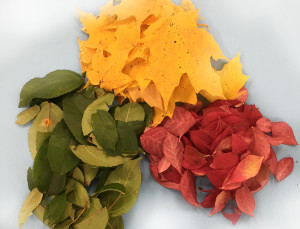 1. Take students on a nature walk to collect leaves. Have students collect a handful of each type of leaf they would like to test. Green leaves work best, but it can be interesting for students to test leaves that have already begun changing colors as well.
1. Take students on a nature walk to collect leaves. Have students collect a handful of each type of leaf they would like to test. Green leaves work best, but it can be interesting for students to test leaves that have already begun changing colors as well.
2. Have students hypothesize why they think some leaves change color in the autumn.
3. Use scissors to cut up the leaves into small pieces and put the leaf pieces into a glass jar. Only one type of leaf should go in each jar.
4. Pour enough isopropyl alcohol in the jar to cover the leaves. Be sure students take the proper safety precautions when working with alcohol.
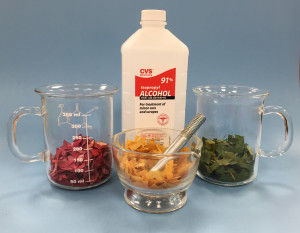
5. Use a pestle or the end of a wooden spoon to muddle the leaf pieces.
6. Cover the jar and let the leaf/alcohol solution sit in a dark place for at least 30 minutes (it is best if you can let the solution sit for several hours or overnight). To speed up the process, you can place the jar in a shallow tray containing one inch of hot water.
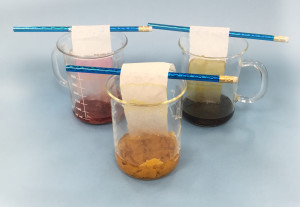 7. Tape a strip of paper towel or coffee filter to a pencil and let the end of the strip hang into the liquid at the bottom of the jar.
7. Tape a strip of paper towel or coffee filter to a pencil and let the end of the strip hang into the liquid at the bottom of the jar.
8. Let the end of the strip sit in the liquid for at least 30 minutes. You want to allow enough time for the alcohol to evaporate from the strip.
9. Observe and record results.
Results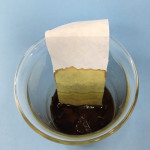
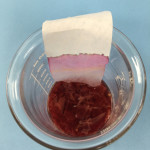
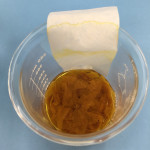
- Depending on the types of leaves used, students should see a variety of green, yellow, orange, and red bands present on the strips.
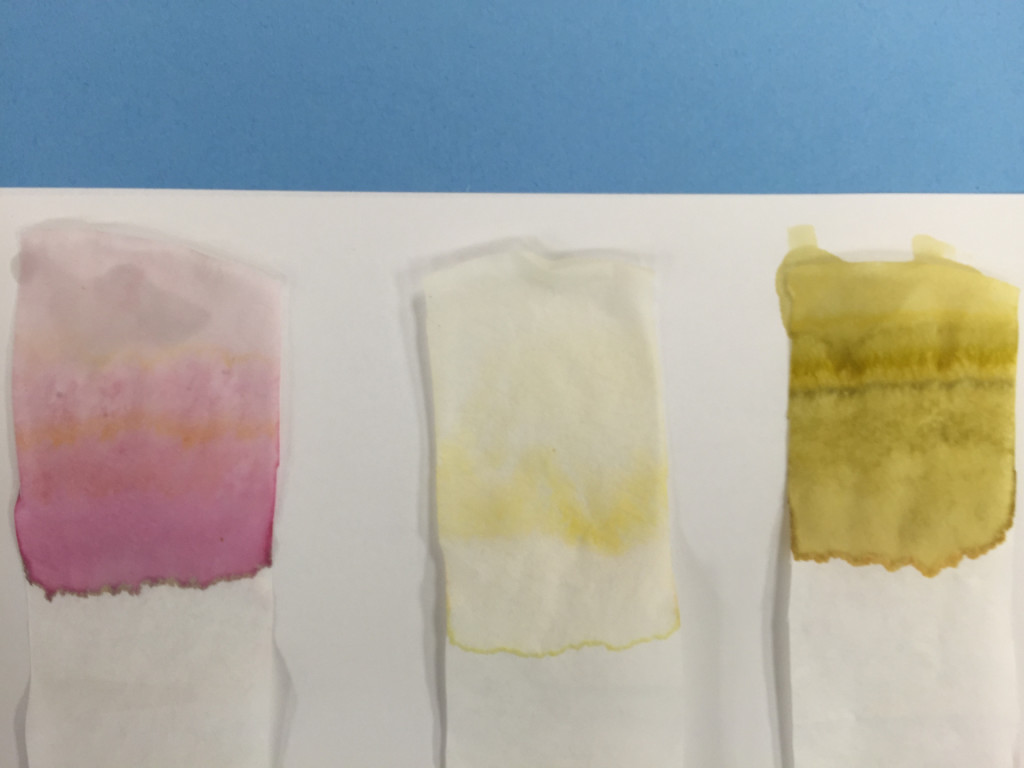
- Allow students to discuss what they think causes the different colors to be present. Explain that leaves contain different pigments, and that the carotenoids and xanthophylls (which cause leaves to turn orange or yellow) cannot be seen during the summer because of the abundance of chlorophyll present in leaves during the summer months. Anthocyanins, which cause leaves to turn red are only present in the fall months.
- Have students hypothesize how they think the leaves they tested will change in the coming weeks based on the results of their chromatography experiment. Take students on a nature walk later in the fall to verify their hypotheses.
Connect to Literacy
- Why Do Leaves Change Color? (Let’s-Read-and-Find-Out-Science, Stage 2) by National Geographic Learning
- I Wonder Why Leaves Change Color: And Other Questions About Plants by Andrew Charman
Additional Resources
- Here is a great video from Bite Sci-zed that shows this experiment in action. You can watch the entire video for background information or skip to the instructions, which start at 2 minutes into the video.
- Why Leaves Change Color from the USDA Forest Service
- Find the Hidden Colors of Autumn Leaves from Scientific American
Linda Dunnavant is a middle school teacher whose blog, “Tales of a Fifth Grade Teacher,” can be accessed here.
What a fun way to enjoy the autumn season. Love it!
I love this experiment perfect for my homework!!!
LOVED it!!!